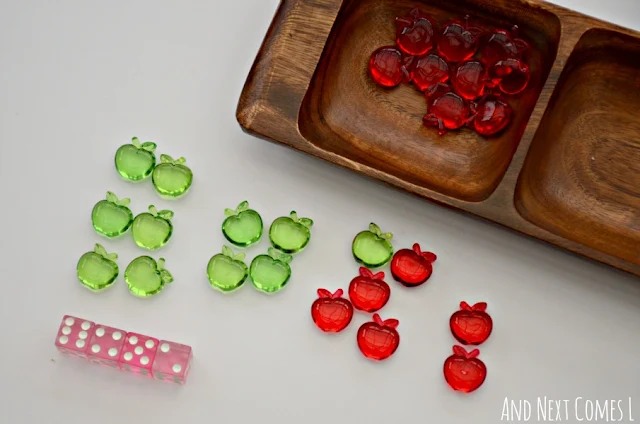Apples, apples, apples - it's that time of year!
And we just happen to have these awesome little acrylic apples that I found at Michaels last year that are perfect for celebrating the season of apples.
In the past, we have sorted and counted apples on the light table and picked them off of a sticky color matching apple tree.
We even worked on fine motor skills, such as scooping and pouring, with them in this apple sensory "soup" bin.
More recently, though, I set up this simple Montessori-inspired preschool apple math activity tray using the acrylic apples. It was a great way to practice counting, one-to-one correspondence, and addition. Yet, as you will see later on, there are lots of ways to adapt and expand the original activity.
Apple Math Activity Tray: What You'll Need
As you can probably tell/see, you don't need much to set up this super simple math tray. Here's what we used:
- Apple manipulatives - We used acrylic apples, but you could substitute apple shaped mini erasers, foam shapes, red or green pom poms, or anything similar that you might have on hand.
- Dice - Feel free to include as few or as many as you want. Just make sure you have enough apples to match all the dots on the dice. You could even consider having a green die and a red die to match the colors of the apple manipulatives.
- A tray to put the materials in - We have a lovely wooden one that has two sections, as you can see in the photos.
I then put the manipulatives in one section of the tray and the dice in the other. Like so:
This Apple Math Activity is Great for Preschoolers & Kindergarten Kids!
For this activity, you simply roll the dice and count out the corresponding number of apples. As you can see below, my son counted out six apples to match the die showing six dots.
Then continued with four, five, and two. And even arranged them into nice little groups.
Then you can add up all the apples in total, which, in this case, there are 17 apples.
Unsurprisingly, my math loving boy, J, was all over this activity. Actually, he's all over any activity that involves numbers and/or dice (see here for example), so I kind of knew that this math tray would be a hit (hello, hypernumeracy!).
He simply rolled the dice and counted the corresponding number of apples.
And rolled some more! Then added them all up.
To be more precise, he would roll all of the dice, quickly add all of the dice in his head, say the correct answer, and then proceed to count out the apples. It's very impressive given his age and the fact that all of this math knowledge came to him naturally (we would later learn it's called hypernumeracy).
Some Variations of this Math Activity to Try
Since the activity is a bit open ended, there are, of course, other ways to use the materials or explore math concepts. So, feel free to get creative. However, here are some ideas to consider:
- Have one green die and one red die. Count out the corresponding number of apples to match the color of the die. For instance, if you roll a three on the green die and a two on the red die, count out three green apples and two red apples.
- Roll two dice and count out the correct number of apples. Roll one die and subtract that many apples. Count up how many are remaining.
- Start with a set number of apples (let's say 10), roll a die, and remove that number of apples. So, if you roll a five, remove five apples. Then count up how many apples are remaining.
- Practice multiplying by rolling two dice and counting out the correct number of apples. Obviously, you'll need up to 36 apples on hand to do this activity.
- Roll two dice and count out apples for each roll and place them into separate piles. Then use an index card with a greater than/less than symbol on it (or you could bend a pipe cleaner into a > shape) and put it between the two piles to show which pile is greater than and which pile is less than.
- You could also graph the numbers you roll each time. Simply roll the die, count out the correct number of apples, and graph the result.
- Explore odd or even by rolling the dice, counting out the apples, and identifying if the number is odd or even.
As you can see, there are lots of different ways to expand this little apple math activity tray. Sure, this simple activity might not seem like much at first, but my son absolutely loved it!








